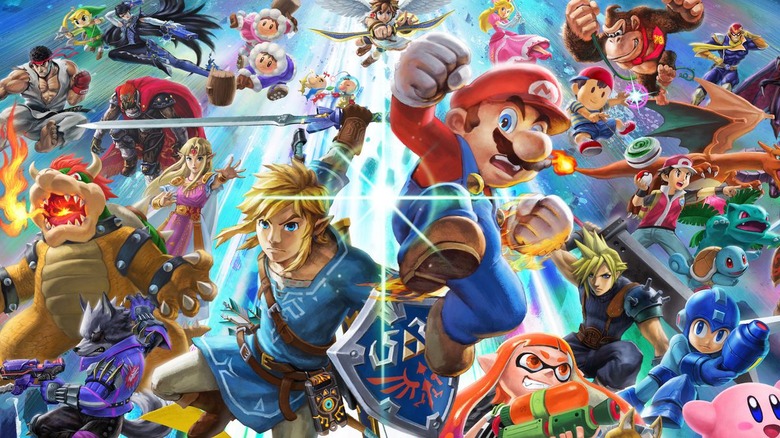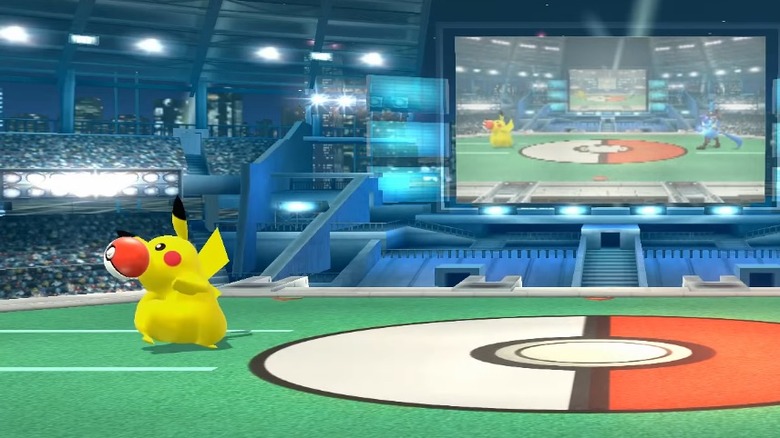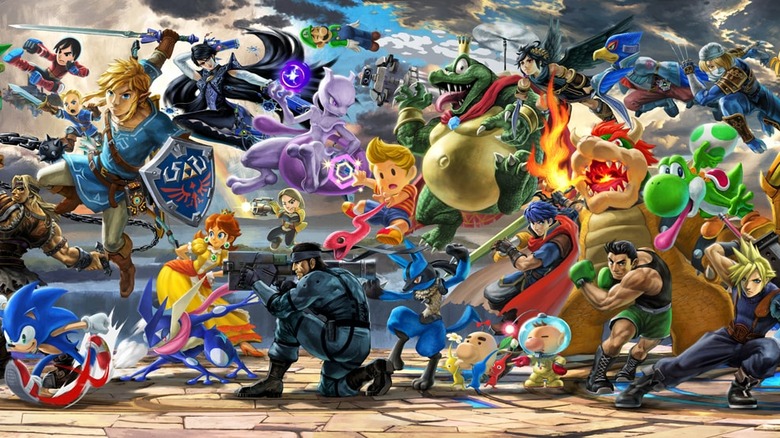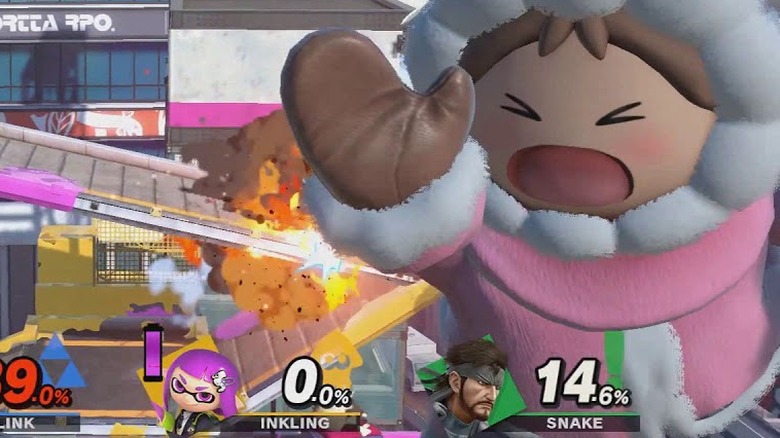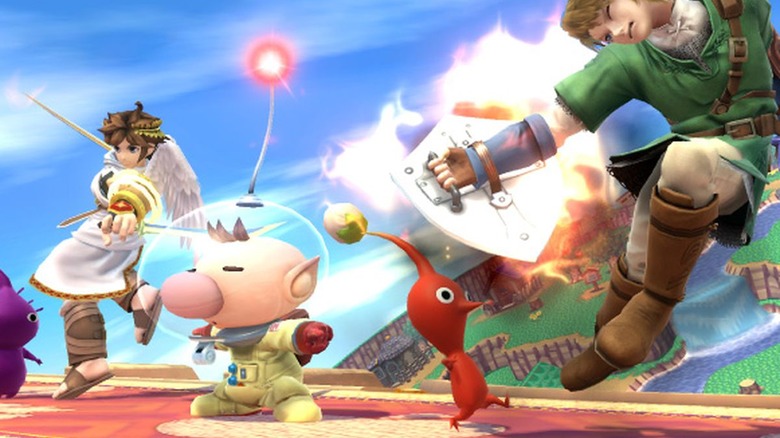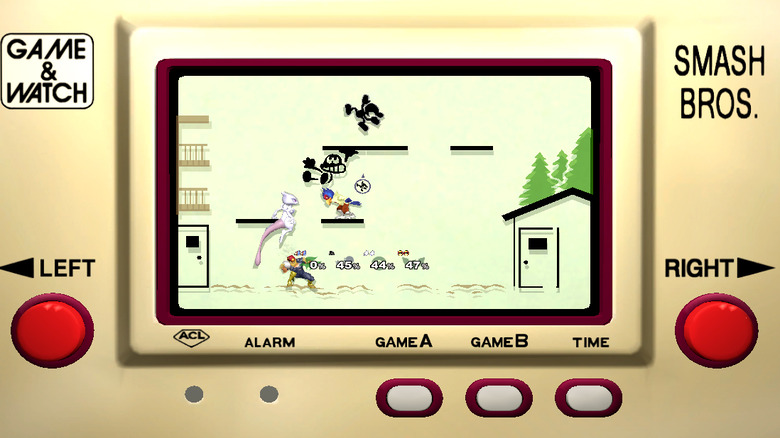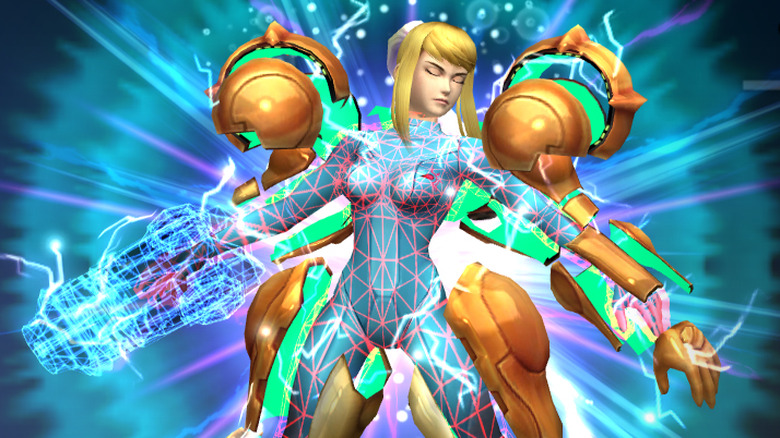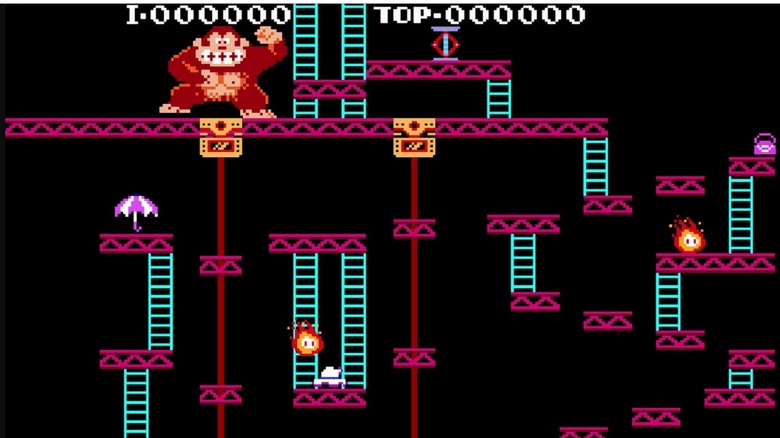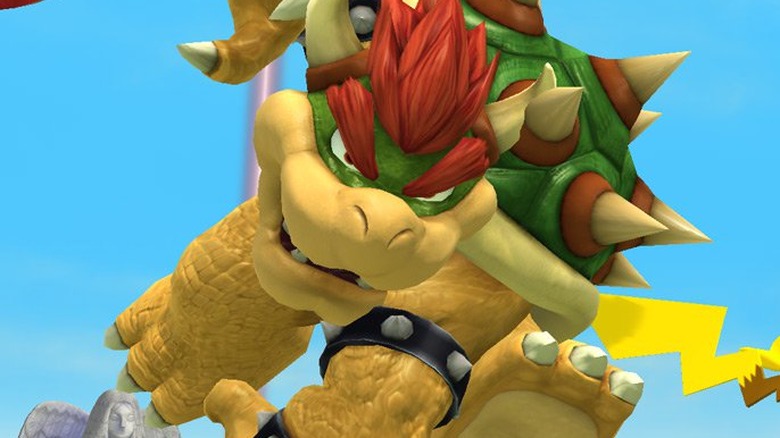Things Only Adults Notice In Smash Bros.
When you think of Super Smash Bros., you're probably not thinking of anything terribly mature. After all, it's just the family-friendly franchise that revolves around Mario beating the snot out of his girlfriend, Metroid's Ridley brutally impaling the loveable Mega Man, and Luigi having his soul literally ripped out of his body. This is a game series for the kids!
Still, even with its (typically) all-ages sensibilities, Smash Bros. isn't devoid of content that might garner a double-take from old-timers. That's why we've rounded up the items on this list: to explore and expose content that Nintendo's put in its most famous fighting game franchise that kids likely won't notice. Because the truth is, Super Smash Bros. isn't just a cartoony brawler where scantily clad Bayonetta can hair-whip Zero Suit Samus and Pac-Man can eat Sonic the Hedgehog alive. There's so much more behind the series' adult-only curtain, be it old references to long-extinct game consoles or disturbing character traits amongst its most famous fighters. Let's take a deep dive into some of the weirder Smash Bros. trivia only adults are likely to catch.
Can Pokemon own each other?
Ever watched a dog walk another dog, or pay for its vet bills? No? Well, good, because that doesn't happen in the real world (at least, not that we know of). In Smash Bros., however, it happens all the time.
Think about Pokemon: their whole schtick is that they're domesticated creatures who live in balls and do battles and chores on behalf of their trainer. That's how it's always been for Pokemon within their own franchise. Smash Bros., however, flips the script on Pokemon and lets them use pokeballs to control other Pokemon. This is a game where Pikachu can summon Darkrai to fight for him with no trainer necessary. Is it weird, seeing these creatures use their brethren as weapons bound by the indentured servitude properties of pokeballs? For sure. But unless you're older, it's probably just another quirky aspect of Smash Bros. that slips under the radar.
A commercially improbable crossover
While a lot of kids might appreciate the immense variety of characters within Smash Bros.' epic, ever-growing roster, it's likely that only adults will be awestruck by the game's all-star lineup from a corporate perspective. After all, it's not like Nintendo just decided it liked a character owned by SEGA or Capcom and chose to plop them in its own game. Nintendo had to get explicit permission and obtain the legal rights to feature all of Smash Bros.' many, many cameo characters. This makes the company's feat of scoring Mega Man for Smash Bros.' Wii U entry that much more impressive, considering Capcom had been neglecting the character for years before Nintendo came around asking to let the blue bomber live on in an ensemble fighter. Similarly, think of the design hoops Nintendo had to go through in order to make Platinum Games' nudity-and-innuendo-prone Bayonetta fit within the franchise's E10+ age ceiling. And how can we forget Solid Snake, the leading man of Konami's bastardized Metal Gear franchise? The fact Nintendo was able to bring Snake back for Smash Bros. Ultimate is a logistical miracle, given how poorly Konami has treated anything with even a passing connection to Metal Gear creator Hideo Kojima.
The fact that Nintendo overcame all of these many, many hurdles to assemble a series roster featuring legendary characters like Cloud, Ryu, Sonic, Mega Man, and many others remains one of the most remarkable corporate achievements in all of gaming.
A not-so-stealthy swap
While it's a miracle Nintendo managed to get Solid Snake back for a second round of Smash Bros. goodness, it's not like that accomplishment came about without any concessions. Though the cause isn't officially confirmed, there's an outstanding chance Snake's logo change in Smash Ultimate is the result of a demand by Konami. The odds of anyone but an ardent Metal Gear fan catching this peculiar, ostensibly corporate-mandated tweak are slim, meaning the odds of any kids noticing it are even slimmer. But for those adults who keep up on corporate politics within gaming, it's not hard to imagine that the erasure of Metal Gear's Fox logo — visible just above his damage percentage, and now changed to the series' iconic exclamation point — wasn't an artistic decision.
Though the Fox logo was present in Brawl, that was before the infamous implosion of the Metal Gear franchise that resulted in Kojima leaving Konami. Afterward, the company made sure anything that was artistically linked to their ex-visionary was as neutered as possible. Case in point, the Fox logo, which was a calling card for Kojima while he was still attached to the franchise.
Olimar's battle of attrition
Mario shoots fireballs. Link fires arrows. Ness swings around a yo-yo. These characters are all making an ethical decision by using inanimate objects as their weapons of choice. But not Olimar. That pint-sized man in the space suit has made it his personal quest to slaughter as many of his ever-dedicated pikmin soldiers as possible within Smash Bros. While Smash is just a fun round of sparring for most of the other characters involved, Olimar's play style emphasizes that he treats the game's fights as battles of attrition, battles in which he has infinite soldiers to dispose of in his quest for dominance.
Think about it: all of Olimar's attacks involve him using his pikmin for some nefarious purpose. Either he's using them as a living rope with which to grab edges, or he's literally throwing his troops at the enemy in an attempt to kill them with blunt force. And because of his use of the pikmin in-game, we're forced to see them die and watch their little souls float away from their bodies. All things considered, Joseph Stalin might make a good echo fighter for Olimar, given how little regard both had for the lives of the people who trusted them. Good luck trying to explain that to your kids playing Smash.
Ode to Game and Watch
If you're looking for a stage in Smash Bros. that pays respect to Nintendo's oldest success in the video gaming sector, look no further than Flat Zone, a stage that has been featured in Smash since Melee. Flat Zone has changed across Smash Bros. entries, but one thing that's remained constant is its unique backdrop which has the stage take place inside a Game and Watch handheld console, making it appear as though Smash is a Game and Watch game. If you're old enough to remember Game and Watch systems when they were hot stuff, Nintendo hasn't forgotten you. In fact, this stage serves as a way to celebrate Nintendo's longest longtime fans by bringing them back to where it all began.
Mr. Game and Watch himself, though not a real character from the Game and Watch days, serves as a sort of amalgamation of the Game and Watch system's stick-figure-esque black pixel people, which populated games on the platform. So, if you're a legacy Nintendo fan and want the true Game and Watch experience, be sure to set up a match of all Mr. Game and Watches on Flat Zone and get ready to party like it's 1980.
Samus' final smash
If you're wondering why Samus' armor falls off and reveals Zero Suit Samus during her final smash in Super Smash Bros. Brawl, there's almost definitely a game design reason for it revolving around balancing the character competitively. With that said, the actual visuals that make the transformation happen are less about game design and more about referencing the ending of the original Metroid, released for the NES in 1986. In that game, at the end, you can see Samus lose her armor and be left in nothing but a sportswear version of the zero suit. Back then, this was Nintendo's way of saying, "You've been playing as a lady the whole time!"
It was a pretty neat surprise, and definitely a big moment for famous females in gaming. Super Smash Bros. Brawl took this iconic moment and managed to include it in Samus' final smash as a tasteful homage to the 1986 classic, which a lot of you older gamers probably remember with fond memories.
The origins of Donkey Kong
If you're playing Smash Bros. and stumble upon a retro-themed stage loaded with pink pixelated platforms and a giant monkey, that's not just any level you're messing around in. That's a throwback level inspired by the very first Donkey Kong game, an arcade obstacle platformer that debuted in 1981. That big simian in the Smash Bros. level is none other than Donkey Kong himself, in his original form. This means you can see old and new DK side by side in the same game. Furthermore, one of DK's alternate color options in Smash Bros. gives his fur a bright reddish-pink hue, another reference to how DK first appeared in 1981 and how his retro throwback incarnation appears in Smash Bros.
For anyone who remembers DK's first appearance, this level is sure to drum up a lot of nostalgia. But it's not just DK fans that have a reason to remember this stage fondly. The oldest of Mario fans remember it as well, as Donkey Kong's first appearance also happened to be Mario's first appearance, back when the Italian plumber operated under the moniker of "Jumpman." To think, how far Donkey Kong and Mario have come since then.
Kamikaze Bowser
For the average Smash player, the rules of the game are simple: keep your stock count high and your enemies' count low. The overwhelming majority of players subscribe to this mantra and, as a result, will fight tooth and nail to avoid losing a stock no matter what the situation.
But there is a special breed of Bowser player out there who knows the true art of war, one entirely unnoticed by most gamers and, consequently, the vast majority of kids playing the game. For adults who understand the advantages of sacrificing one's self for the greater victory, Bowser is equipped with a tactical suicide move that can take you and an enemy off the map. His side-B attack, if done near the edge of a map, will prompt Bowser to grab a nearby opponent and drag both himself and them into the abyss. Is it morbid? Sure. But there's something to be said for sinister, smart adults who know Bowser's all about victory by any means necessary.
When is Bowser's kamikaze attack useful? Say you're in a team battle and one of your opponents is carrying the enemy to victory. If you're willing to sacrifice yourself, you can tank the opponent no matter his damage percentage. Another scenario is when you have the stock lead in a tense 1-v-1 and don't want to afford your opponent the chance to come back from the brink. For mature Bowser players, mutual destruction is as good a path to victory as any.

